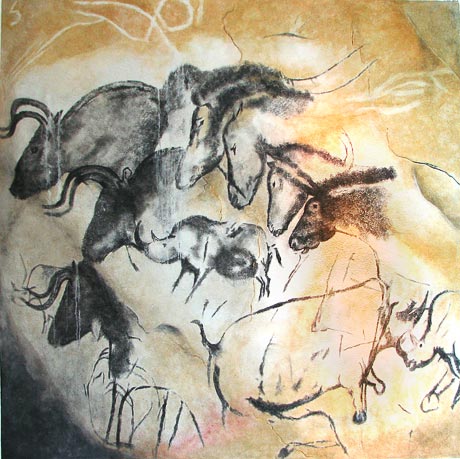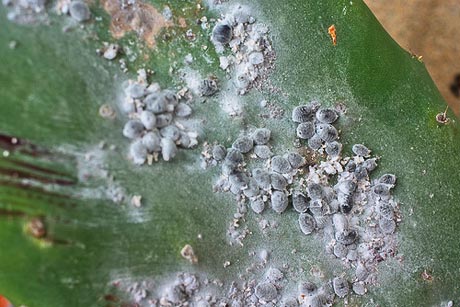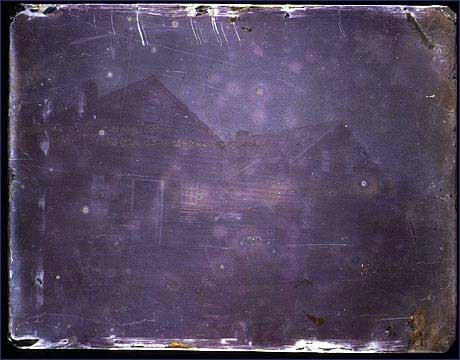Ochre - Handprints of humankind's first Picasso

In 1994, three French speleologists discovered a massive, hidden cave in southern France. The geologic marvel was littered with the skulls and bones of cave bears and wolves, and contained a discovery that marked the prehistoric beginning of humankind's fascination with color - a small drawing on the wall done in red ochre.
The Cave of Chauvet contains some of the oldest examples of art created by humans. Our best guess places these particular prehistoric Picassos at about 30,000 years ago. The actual paintings are startling in their quantity, their variety and the fact that both charcoal and red ochre, derived from a naturally tinted clay, were used to create these animal portraits.
What's also fascinating is that, well, they're good. The representations of animals as varied as cave bears, lions, mammoths, rhinos and owls, are startling in their quality. It almost makes you wonder if someday, someone will stumble across a cave full of really bad practice paintings.
How did it change the world?
Reflecting a debate about art that sometimes continues to this day, there's some question as to why exactly the artists created these masterpieces. There are some theories about whether they painted for spiritual or ritualistic reasons, as a form of communication, or for some other reason, but we'll never know for sure. But we do know that the site is the first known location of one of humankind's greatest evolutions – the desire to use color to reflect the surrounding world through the creation of art.
Carmine – Why there are bugs in your yogurt
Carmine is a bright red pigment used in everything from artificial flowers to cosmetics. And, it's common to find carmine as an additive in a wide variety of foods. Which is a little surprising, since carmine is made from boiled insects.

Cochineals, the bugs in question, are little parasites that live on cacti. They were originally harvested for use as a pigment thousands of years ago, by the Aztec and Maya people of North and Central America. Among other things, the Aztecs used the pigment to dye the robes worn by their emperors. It was so valued that cities conquered by Montezuma paid their tribute to him in bags of cochineal dye.
How did it change the world?
It wasn't carmine that brought Spanish explorers to the New World, but once there, they learned to love it. Soon after the beginnings of Spanish colonization, carmine became the second most important export back to Europe, after silver.
Beginning in the 1500s, it became widely coveted in the Old World as a dye for clothing, and was even used to make the red robes of Roman Catholic Cardinals, and the coats of the British military. Interestingly, the Spanish actively misled Europeans about where it came from, implying it was derived not from insects, but from berries or grain.
The high demand for carmine was one of the main economic impetus' behind the rapid and thorough colonization of the New World. So it wouldn't be an exaggeration to say that the history of both the colonizers and the colonized were written, at least partially, in bright, red letters. To read much more about the history of the dye, check out Amy Butler Greenfield's fascinating book.
Mauve – A teen's failure launches a new industry
Imagine accidentally discovering a new color. That's exactly what an eighteen year-old chemist did in 1856. William Henry Perkins was attempting to create artificial quinine, a substance used to treat malaria victims, but his experiment failed.
While cleaning up afterwards, he mixed alcohol with the residue left in a flask and was surprised to notice that a new substance had formed – mauveine. True, the color mauve existed in nature, but this was the first time it had been artificially created in a lab, and in a form that conveniently lent itself to use as a textile dye.
How did it change the world?
Mauve clothing soon became all the rage in England, spurred in part by the mauve dress worn by Queen Victoria to her daughter's wedding in 1858. As the first synthetic dye in history, mauvine was groundbreaking on a few fronts. For one, it marked a revolution in textiles and fashion. Prior to the discovery of synthetics, dyes made from natural substances tended to be inconsistent in color, and were prone to fading with age.
But mauveine was the first dye that created a rich, consistent and long-lasting color. More importantly, it gave rise to the synthetic chemical industry. Prior to this, chemistry and commerce seldom mixed. Perkins' discovery was that first stepping stone that led directly to further industrial applications of chemistry in medicine, photography, perfume and even explosives.
Check out Simon Garfield's book all about William Henry Perkins and the discovery of mauve.
RGB (Part 1) – The First color photograph

In 1861 the first permanent color photograph was taken. Rather, three different black and white photographs were taken, each with a different color filter, red, blue and green, placed in front of the lens. The three resulting images were projected together to form an accurate, though somewhat blurry, representation of a tartan ribbon, in color. This breakthrough in photographic technology was the work of a physicist named James Clerk Maxwell.

Or so we all thought for many years. But in 2007, the story suddenly and dramatically changed. Back in 1850, an American minister named Levi Hill, claimed the “world's first color photograph” crown for himself. He was widely disparaged as a fraud. Experts claimed that his process, eponymously named the Hillotype, was incapable of producing a color photo.
Instead, they charged, he had hand-dyed the black and white original to give it the appearance of color. It wasn't until an extensive study of his first hillotypes, conducted recently by researches affiliated with the Smithsonian, that the truth of the matter was revealed. He had been a fraud – his 1850 image was indeed hand-dyed. But the dye was responsible for only some of the colors. He actually had succeeded in creating a photograph with authentic reds and blues, the first color photo in history.
How did it change the world?
Regardless of who created the first one, the effect of color photography on our world today is both extensive and profound. From those humble beginnings, through to the launch of the first modern color film in 1935, all the way up to the digital revolution of today, color photography has become incredibly prevalent and available. In the hands of journalists, artists and the public, color photography has captured and even influenced some of the most important events of the last hundred years.
And now with the wide availability of inexpensive cameras, coupled with the perfect storage and sharing medium that is the internet, it's safe to say that at no point in human history have so many photos existed at the same time. (What is difficult to know is exactly what percentage of them are self-portraits taken by people in front of their bathroom mirror.)For much more on the history of color photography, drop by the amazing color and design blog, Colour Lovers.
Red - Unlocking the origin of the universe
You may not know what it's called, but it's safe to say that you are familiar with the Doppler Effect. It's responsible for that distinctive sound an ambulance's siren makes as it moves towards you, then passes you and speeds away. Hear an example of the effect on YouTube. It's caused by sound waves hitting you at a faster rate as the noisy object approaches, due to a shortened wavelength.
After it's past, the sound waves reach you at a slower rate, thus changing the frequency of the sound. But what does all this have to do with color? Light waves behave in the same way as sound waves. That is, when an object that emits light moves towards us, the light waves undergo a change in wavelength, compared to when that light-emitting object is moving away from us.
It's all a bit complicated, but the crux of the matter is that when a light-emitting object, such as a distant galaxy, moves away from us, the light emanating from it undergoes a “red shift”...literally becoming more red due to the change in wavelength.
How did it change the world?
About 150 years ago, astronomers noticed this red shift in the light coming from various galaxies in the sky. From that, they deduced that those galaxies are moving away from us. But then they noticed something peculiar: every single galaxy is moving away from us.
And that could really only mean one thing -- that the universe is constantly expanding. It took a few years, but this realization eventually led to an even more important a-ha moment. If the universe is constantly expanding, that means that, at some point in the past, all of the matter in the universe must have been much closer together. And then it must have exploded. And so was born the Big Bang theory.
While this red shift didn't necessarily change the world, it certainly had a profound influence on our understanding of the universe.
RGB (part 2) – The colors of entertainment

Nowadays we take color TV for granted, and watch it for an average of between two and four hours a day. But this particular invention took a long, torturous path to get to where it is today. It's impossible to actually pinpoint a time when color TV was “invented”. In attempts to do so, all kinds of systems were developed and most failed miserably.
The first true color broadcast happened all the way back in 1938, but it was only broadcast to a single screen. The first coast-to-coast broadcast of color TV happened in the U.S. in 1954. Of course, at that time nobody owned a TV capable of showing the broadcast. A few months later, the first consumer color TV was put on the market by Westinghouse. It cost $1,295 dollars, or about $10,000 in today's dollars. It wasn't until the 1966-67 broadcasting season that all the major US networks were airing full color prime time schedules.
How did it change the world?
Color TV became widely available in the US at about the same time that images from the Vietnam War began being broadcast on the nightly news. This prompted esteemed BBC broadcaster Robin Day to wonder if a democracy could ever wage a war again, when “The full brutality of the combat will be there in close up and color, and blood looks very red on the color television screen.” Subsequent events have proven him wrong, unfortunately. But on a broader societal scale, how has TV changed us? Well, it depends on who you ask.
